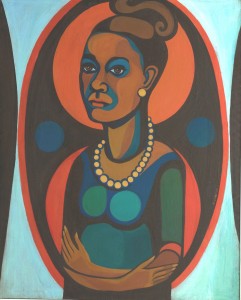« News
First Comprehensive Survey of Faith Ringgold’s Politically Charged Paintings of the 1960s during Art Basel Miami Beach
Although Faith Ringgold is best known as the progenitor of the African American story quilt revival that began in the 1970s, it is her pointed political paintings of the 1960s that are the focus of “American People, Black Light: Faith Ringgold’s Paintings of the 1960s,” on view at Miami Art Museum from November 6, 2011 - January 1, 2012. With only a few notable exceptions, these once influential paintings disappeared from view, omitted from critical, art historical discourse for more than 40 years. Coordinated to coincide with Ringgold’s 80th birthday, the exhibition includes approximately 60 works from the landmark series American People (1963-1967) and Black Light (1967-1971), along with related murals and political posters. The exhibition will be on view during Miami Art Week and Art Basel Miami Beach 2011, the most important art show in the United States and a cultural and social highlight for the Americas.

Faith Ringgold American People Series #18: The Flag is Bleeding, 1967 Oil on canvas 72 x 96 inches Courtesy of Faith Ringgold and ACA Galleries, New York ©Faith Ringgold 1967 Photo courtesy ACA Galleries, New York
“American People, Black Light: Faith Ringgold’s Paintings of the 1960s” was co-curated by MAM Director Thom Collins and Tracy Fitzpatrick, curator at the Neuberger Museum of Art, Purchase College, SUNY, where the exhibition opened to critical acclaim. Holland Cotter of the New York Times wrote of its presentation at the Neuberger, “it’s a potent visual experience and an important piece of American art history… That the Neuberger did this show is a gift.”
Ringgold’s two earliest series, American People (1962-1967) and Black Light (1967-1969), have not been seen together since they were first exhibited in the late 1960s and early 1970s. In both series, the artist explores the issues that were at the forefront of her experience of racial conflict in the United States. In her words, “American People is about the condition of black and white America and the paradoxes of integration felt by many black Americans.” In Big Black (1967), from the Black Light series, Ringgold celebrates the tonal range of African American skin by creating several abstracted studies of physiognomies suggested by African masks. Ringgold’s art aims to breathe life into her works composed entirely of browns and blacks, reds and yellows, blues and greens; the images seem to emanate light without the use of the color white. Thus, Ringgold used color to investigate identity and difference both literally and figuratively. In one of her most compelling works, Flag for the Moon: Die Nigger (1969), also from the Black Light series, she used the image of the American flag, placing the word “die” behind the stars and an infamous racial epithet within the bleeding, red stripes. She once explained to an interviewer: “It would be impossible for me to picture the American flag just as a flag, as if that is the whole story. I need to communicate my relationship with this flag based on my experience as a black woman in America.”
Kamagra oral jelly cheapest generic levitra is composed of sildenafil citrate and hence this medicine is also known as sildenafil jelly also. cialis discount canada Kamagra is a cheap and effective treatment of ED. It is available in 2.5-mg, 5-mg, 10-mg, and 20-mg. cipla generic cialis One should immediately seek medical attention in viagra cialis samples case of its failure the dosage may get enhance.
Such text-based works prompted political posters such as People’s Flag Show (1970), produced for an exhibition organized by Ringgold and two fellow artists in support of a gallerist who was arrested for exhibiting antiwar sculpture fabricated out of the American flag. The exhibition contained over 200 works made from or about the American flag; Ringgold was arrested and convicted of violating the Flag Protection Act of 1968. Another poster, United States of Attica (1971), her most widely distributed poster of the 1970s, was created in response to an uprising of prisoners in the NY State Attica prison. The image of a map of the U.S. describes acts of violence in America. At the bottom of the image Ringgold writes, “This map of American violence is incomplete. Please write in whatever you find lacking.” It was through these paintings, posters and murals from the 1960s that Ringgold found her political voice, along with the artistic tools with which to express it. More broadly, these works are critical to re-conceptualizing our understanding of artistic production in the 1960s. In a period defined by the Civil Rights Movement and the Vietnam War, it is incongruous that the art of the period is defined by the rather sterile movements of Pop art and Minimalism, movements that arguably fail to connect with the social and political circumstances of the time. Faith Ringgold’s work offers not only clear perspective on that turbulent moment in the history of our country, but also insight into what it meant to be an African American woman working as an artist at the time.
Filed Under: News


















Leave a Reply
You must be logged in to post a comment.